The world has fallen in love with Japanese cuisine. It has even been recognized as intangible cultural heritage by UNESCO. You probably know all about the big stars of Japanese food: sushi, noodles, onigiri. Maybe you've even tried some stranger Japanese dishes, like the opinion dividing natto.
But have you ever heard of chinmi? Chinmi 珍味 literally means "rare taste," but it also contains the meanings of acquired taste and delicacy. To give you some context of what sort of food qualifies as a chinmi, the word is also used to describe some non-Japanese foods such as caviar, truffles, and foie gras, which are described as sekai no sandai chinmi 世界の 三大珍味, the world's top three delicacies.
The idea of chinmi pops up in Japanese popular culture across the spectrum from the surreal Toriko to the classic Oishinbo. Seeking out strange gourmet dishes is possible in the real world too. Even for Japanese people, these are a little out of the ordinary. If you really want to level up your Japanese food appreciation, seek chinmi out. Some of them are hard to find. Some of them are hard to stomach. Some of them are hidden gems.
The Top Three
Uni (sea urchin), karasumi (dried mullet roe), and konowata (salted sea cucumber innards) reign supreme in the world of chinmi. These three are the most popular and widely available.
Uni

The spiky little sea urchin, or uni, is valued for its roe (ripe eggs). You can easily find uni topping donburi or gunkan sushi across Japan. However, the most famous regions for uni production are old Echizen province (now Fukui prefecture) and the cool northern waters of Hokkaido. Living in Hokkaido, I had many chances to eat top notch uni. Unfortunately, I never made the most of it since I'm not really a fan. I felt pretty bad about wasting this opportunity since uni is a very pricey delicacy, with top quality uni fetching $450 per kilogram. Even if I can't give you my personal recommendation, if you want to try one of Japan's top three tastes then give uni a try. As a side note, sea urchins got their English name from their resemblance to hedgehogs, who have a wide variety of nicknames including urchin and furze-pig. Aww uni are cute, gourmet, little sea-hedgehogs.
Karasumi
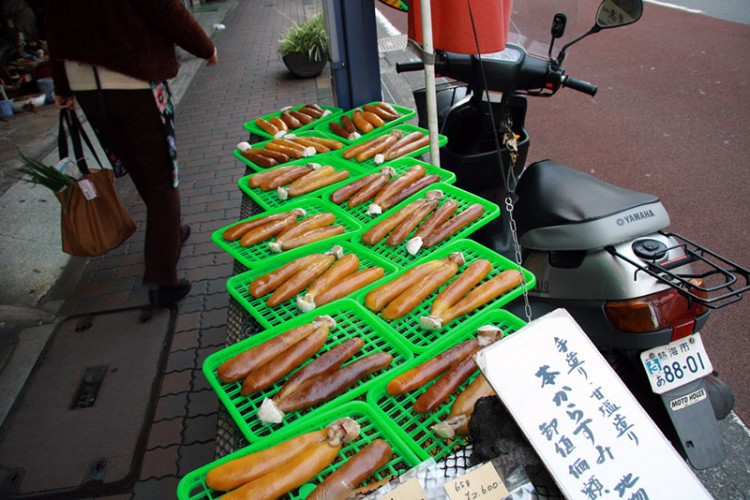
The name karasumi supposedly comes from it's resemblance to sumi (ink sticks) from China (kara). Karasumi is very similar to the Mediterranean dish botargo. Both are the cured roe pouches of the mullet fish. Karasumi is typically soft, while botargo is harder. Karasumi is made by salting mullet roe and drying it in the sunlight. Karasumi becomes even more of a delicacy if it's given a sake bath or smoked. There are plenty of different karasumi to try. Traditionally served as a side to sake, thanks to its powerful umami flavor, karasumi has also become a popular ingredient in a wide array of dishes, such as this karasumi pasta.
Konowata
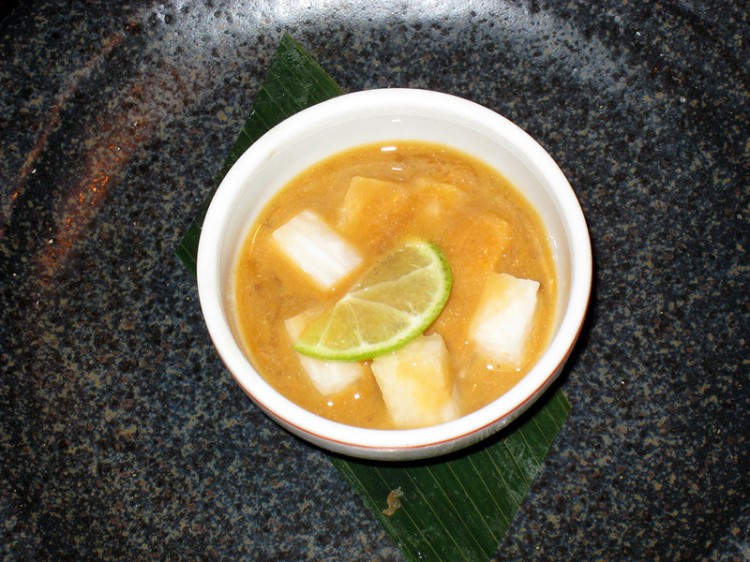
Konowata is made from the cured entrails of sea cucumbers. Sea cucumbers are pretty fascinating creatures in their own right (even before they have their guts scooped out and turned into something you can eat.) Sea cucumbers don't have brains, they barely even have a nervous system and they aren't vegetables, despite what the name suggests. They are echinoderms from the class Holothuroidea. In Japanese they are called namako 海鼠 which literally means sea mice. Squishy, sausauge shaped creatures that live on the bottom of the sea probably don't seem very appetizing. Yet, their guts are highly valued in Japan. First, the entrails are scooped out. Then, they are cleaned thoroughly. Salt is added and the mixture is stirred frequently for about 5 hours. The final step is putting it in a barrel for a week to let the intestines' own enzymes work on turning themselves into finished konowata. Since sea cucumbers aren't very big, the process doesn't produce high volumes. A 100 gram jar will set you back about 3000 yen. The final taste is briny and pungent, verging on putrid. It is often served with sake and sometimes even served in sake. That makes it slide down easier.
Rarer Rare Tastes
If you've mastered Japan's top three chinmi, how about seeking out some of the other ones? Just because they didn't make the top three, doesn't mean they aren't delicious and/or disgusting. Either way, they are certainly worth hunting down. Even if rare tastes aren't your thing, at the very least, forewarned is forearmed. I know from personal experience how much some people get a kick out of watching others try these dishes. I wish I'd known what I was eating before I tried some of these. So here are a few of my top chinmi recommendations/warnings.
Kusaya
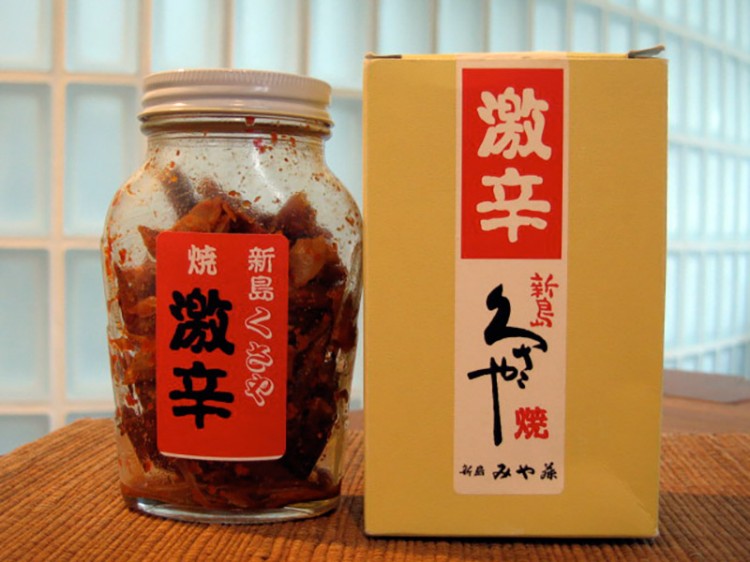
You know when a food is described as "famously malodorous" it has got to be good. Kusaya has a pretty interesting history. It comes from the Izu islands, the tropical island chain that is technically part of Tokyo. In the Edo period, the people there made a living from salt production and paid their taxes in salt because they didn't produce enough rice. This left the islanders with little salt to use themselves to preserve their food. They frugally reused the salty brine which they cured fish in over and over again. The brine, called kusaya eki くさや 液 became sticky and stinky and so did the cured fish, which is called kusaya. The kusaya eki, or kusaya juice, was also used as a medicine. These days, each of the inhabited Izu islands has a different brand of kusaya, with Hachijo-jima and Niijima being particularly well esteemed.
Shutō
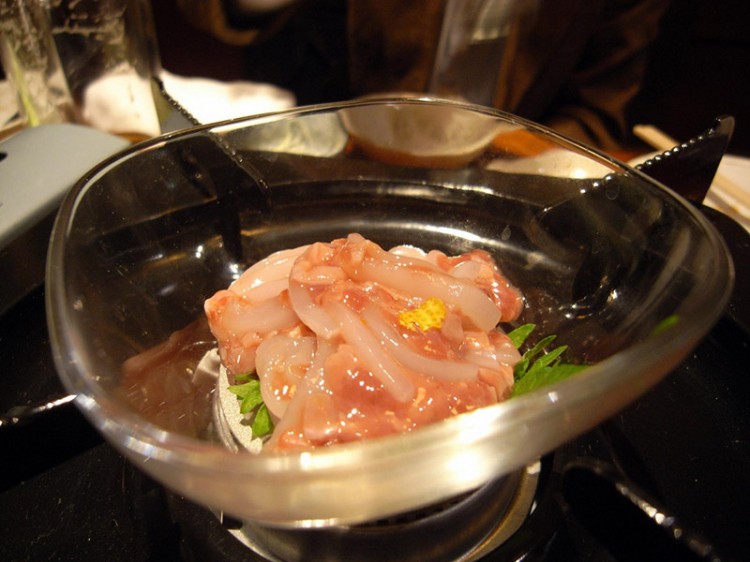
The kanji that make up the name shutō 酒盗 mean sake thief. This name indicates shutō's typical accompaniment, alcohol. Actually, most chinmi are usually served as sides while you are drinking. (Perhaps the alcohol helps distract from the fact you are eating pickled sea stuff.) Shutō itself has one of the most stomach turning descriptions. It is made from the entrails of the bonito (katsuo), a fish more widely known as an ingredient in Japan's ubiquitous stock dashi. The guts are mixed with sake, honey, and mirin. After six months of fermenting, it's ready to eat with a nice glass of sake. You are most likely to find shutō in Odawara city in Kanagawa prefecture.
Dorome
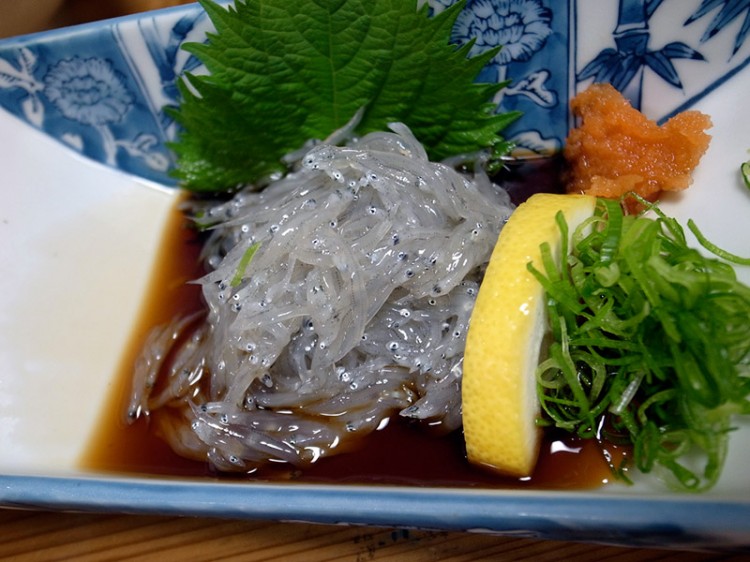
Dorome is a speciality of Akaoka Town in Kouichi prefecture. It takes the alcohol-chinmi link to new heights as it is celebrated in the Dorome Matsuri, a festival that involves a men vs women sake drinking competition. The dorome themselves are a type of young anchovy fry that are eaten whole, similar to whitebait. The Dorome Matsuri may be more about drinking than it is about dorome, but the fish are pretty good too, especially with ponzu sauce.
Tonburi
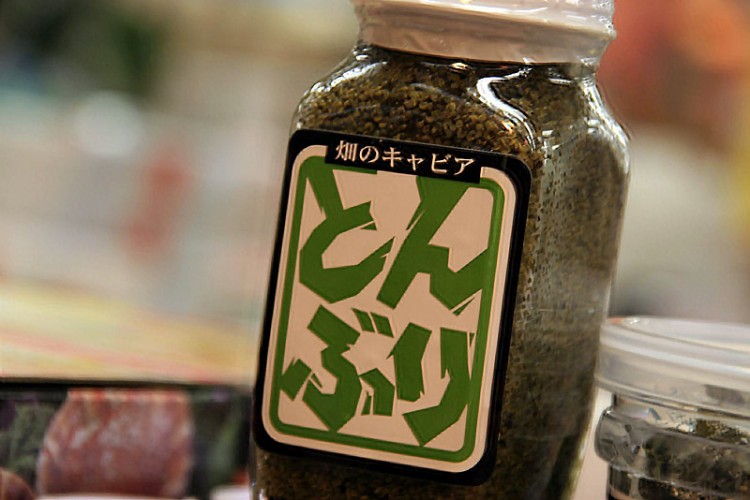
Akita prefecture brings us a chinmi that isn't made of marine stuff! Tonburi is made from the Bassia scoparia plant, also known as the burning-bush, Mexican fireweed, or hōkigi (ホウキギ), depending on where you find it. The seeds of the hōkigi plant are dried, boiled, soaked, and then rubbed by hand to remove the skins. Although it isn't made from fish, it seems even this plant-based chinmi can't escape the marine connection as tonburi is sometimes called "land caviar" as its texture resembles fish eggs. The little dark green seed pods are often used as a garnish.
Fugunoransounonukadzuke
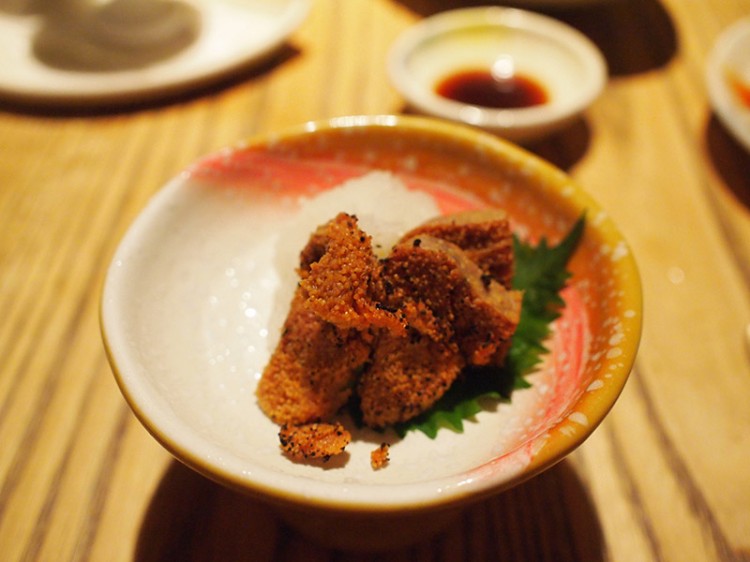
I had to include something made from fugu. This is Tofugu, after all. You've probably heard of fugu, the fish that can kill you if it isn't prepared properly. Well how would you like to eat a fugu's ovaries? Usually this would be a very bad idea, as the ovaries contain very high levels of the potent neurotoxin tetrodotoxin. Chefs train for years to learn how to cut out the ovaries without contaminating the rest of the fish. Of course, some clever person looked at all those discarded toxic ovaries and thought, "what a waste." In Ishikawa prefecture, a technique was developed to make the ovaries edible. They are salted and pickled for almost two years. This renders the toxins harmless. Even so, each batch must be tested by the Ishikawa Prefecture Preventive Medical Association before it can be sold. Would you dare to eat Fugunoransounonukadzuke?
Tofuyo
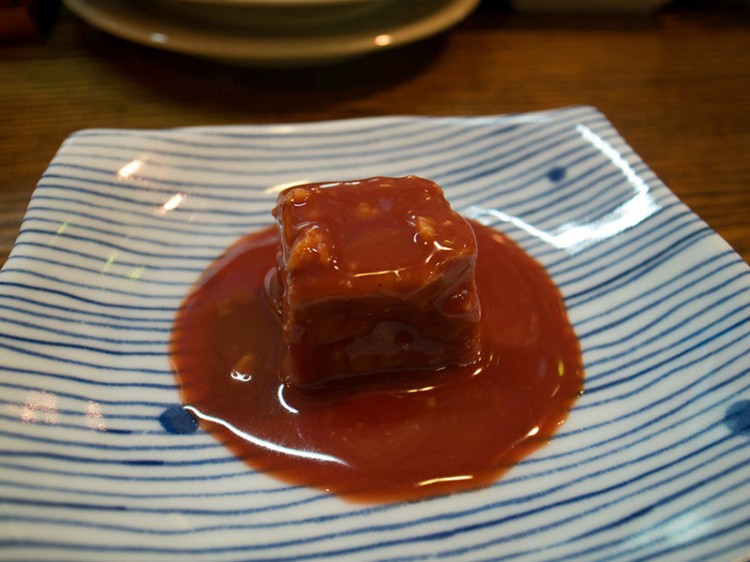
The other half of Tofugu is tofu, so here's a tofu based chinmi. Tofuyo is a delicacy from Okinawa, characterised by its red color and pungent smell. It is made from shimadofu, Okinawan tofu that is a little harder than other Japanese tofu. It is fermented with benikoji, or red yeast rice, and the local Okinawan distilled spirit awamori. The bright red color of tofuyo comes from the mould Monascus purpureus. Apart from being yummy, tofuyo may also have health benefits. A 2012 study found that tofuyo increased the life span of mice infected with influenza. Stinky and healthy – yum!
Karashi Renkon
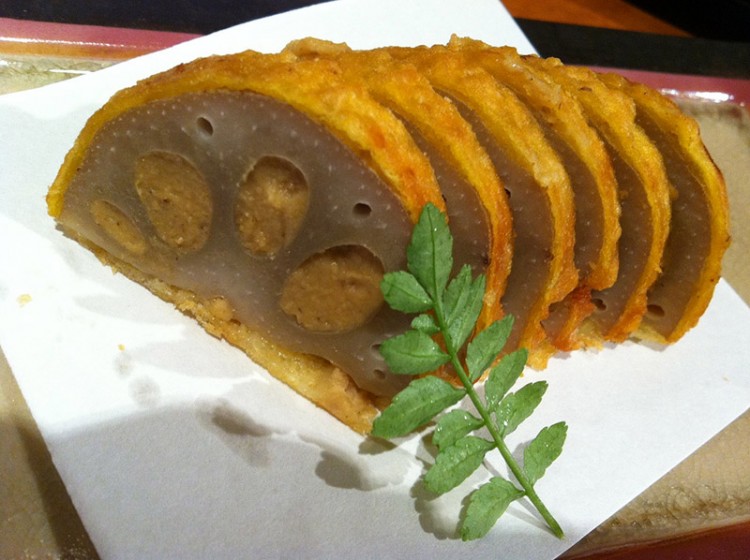
If you like mustard, karashi rekon is the delicacy for you. It's from Kumamoto in Kyushu and comes with a legend attached. The daimyo of Kumamoto, Tadatoshi Hosokawa became sick. In some versions of the story a zen monk called Gentaku, and in other versions a kitchen worker named Heigoro, presented the sick Hosokawa with a lotus root that had been boiled, stuffed with a miso and mustard paste and deep fried. Supposedly, this cured Hosokawa. Conveniently for the story, sliced lotus root looks a lot like the mon (family crest) of the Hosokawa family. It is important to note that karashi renkon should be quite thinly sliced before you eat it. It is often sold whole, but if you try to take a big bite, you're going to have a bad time
Hebo
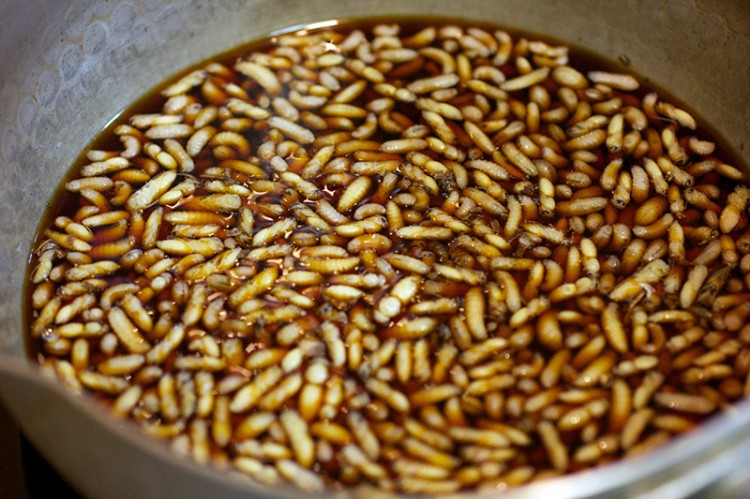
It wouldn't be an article about unusual foods without some insect action. This one comes courtesy of Gifu prefecture where they cook up a delicious meal of black hornet larvae. It is also sometimes called hachinoko (hornet's children). The honeycombs are collected before summer to encourage the hornets to build larger combs. The larvae are plucked out and boiled in either soy sauce and sugar or honey. If you don't like your hornet larvae sweet, you can also try them as a sushi filling. Now, I haven't actually tried these, but I would given the chance. As I always say, why not eat insects? These bugs were an important source of protein for generations in Japan.
Kurozukuri
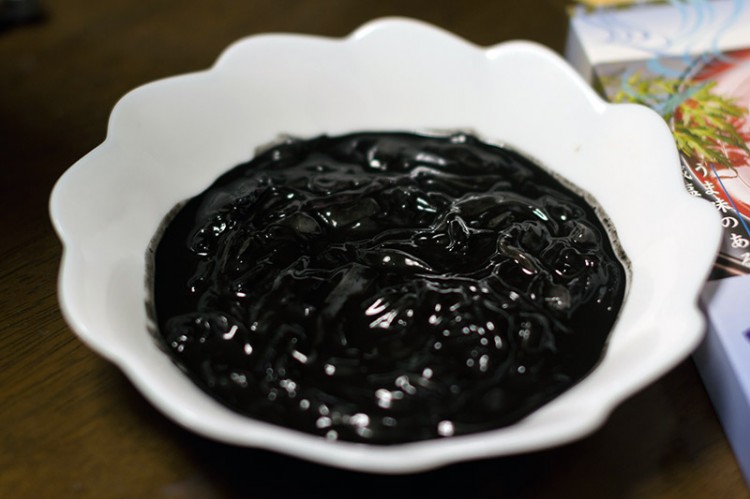
The last chinmi I'll introduce you to today is the dramatically black kurozukuri. It gets its color from squid ink. Squid is salted and mixed with its own ink and liver. It is then left for over a month, undergoing fermentation by various different microbes including, Staphylococcus saprophyticus and Weissella paramesenteroides. If you like the sound of that, go find some kurozukuri in Toyama prefecture and pick up a copy the manga or watch the anime of Moyashimon: Tales of Agriculture to learn more about the wonderful world of the microbes in your food.
Chinmi and the History of Japanese food
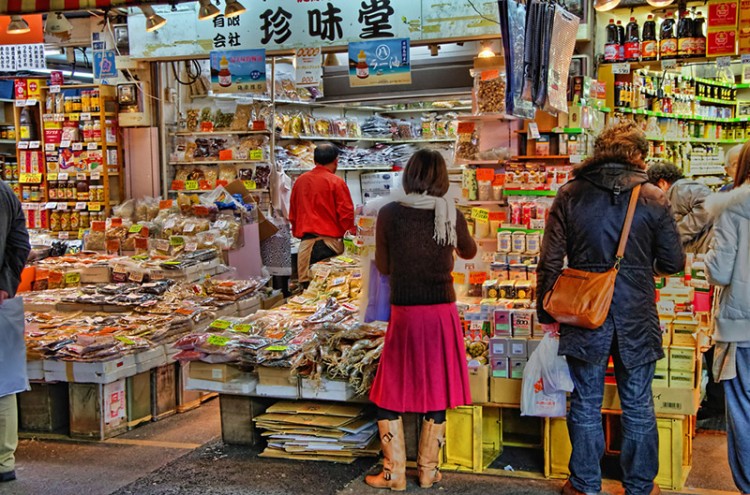
You might have noticed a theme running through many of the chinmi I've just described, fermentation and preservation. The Zenchinrin Association, which promotes chinmi, classifies chinmi into groups; smoked, salted, marinated, pickled, roasted, dried, and boiled. All of these techniques are used to prevent food from spoiling. Japanese cuisine as we know it now is very different than it was even 100 years ago. From a food production standpoint, Japan was not an easy country to live in. While it is rich in resources such as sea food, there were cultural and logistical problems in farming animals for food. Before the introduction of the refrigerator and food imports, people relied on preservation techniques to store enough food to keep them going through hard times. Chinmi illustrate the inventiveness of Japanese cuisine in making the most of the resources available.
These days many people, Japanese or foreign, would rather have a plate of curry rice than a dish of fermented fish guts. I'm probably one of them (curry rice is delicious!). However, if you have the chance to try some chinmi, just screw up your nose and put that stuff in your mouth. Maybe you won't like it the first time you try it. Maybe you'll love it. Either way, you'll have a better appreciation of how lucky we are to be able to make choices about our foods. Also, you can gain an appreciation for the background that some of your favorite Japanese foods like sushi and miso emerged from. The chinmi are a window back into Japan's past. Many of them have dwindled to little more than oddities, even for Japanese people, but they show us that some of the techniques our favorites share are still alive (just as the microbes that make them are still alive too).
